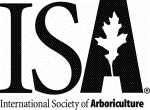
| Current Articles |
| Browse Archives |
| Search |
| Contact Us |
| AUF Home |
 |
Arboriculture & Urban Forestry Online
| Volume 34, Issue 2 —
March 2008
https://www.isa-arbor.com/Publications/Arboriculture-Urban-Forestry |
|
Root Pruning and Stability of Young Willow Oak (View PDF) E. Thomas Smiley Abstract: Two root-pruning methods simulated construction-related trenching and individual root cuts such as from decay after root pruning. Tree trunks were pulled to an angle of 1° from vertical using measured force. A third of the study trees were pulled to failure to determine the relationship between the 1° pull force and the pull-to-failure force. The regression had correlation with r2 equal to 0.76. Utility trenching was simulated with linear cuts across the root zone. Measurable decreases in force applied occurred when cuts were within three times the trunk diameter from the trunk. Force decreased by 35% when a tangential cut was made at the trunk. When individual roots were severed, the pull force was reduced with each root cut. When one root was severed, the decrease in force averaged 12%; when half of the exposed buttress roots were severed, the decrease was 30%. Arborists should avoid cutting any tree roots near the trunk. Linear trenching should not be closer to the trunk than a distance equal to or greater than three times the trunk diameter. Keywords: Construction damage; pull testing; root anchorage; root barrier; root decay; root plate; utility trenching; windthrow |
Current Articles
| Browse Archives | Search | AUF Home | ISA Home
| Get Acrobat